Hawk
Buteo
While the Ferruginous hawk is the largest specie in the USA, Asia’s Upland buzzard is the biggest overall.
Advertisement
Hawk Facts
- Prey
- Rodents, gerbils, squirrels, voles, and chipmunks.
- Main Prey
- Rodents
- Name Of Young
- Chicks
- Group Behavior
- Flocks
- Fun Fact
- While the Ferruginous hawk is the largest specie in the USA, Asia’s Upland buzzard is the biggest overall.
- Biggest Threat
- Habitat loss
- Most Distinctive Feature
- Slender wings
- Distinctive Feature
- Hooked beak
- Other Name(s)
- Buzzard, raptor
- Wingspan
- 26 to 63 inches
- Diet
- Carnivore
- Lifestyle
- Diurnal
- Favorite Food
- Rodents
- Common Name
- Hawk
- Number Of Species
- 269
- Migratory
- 1
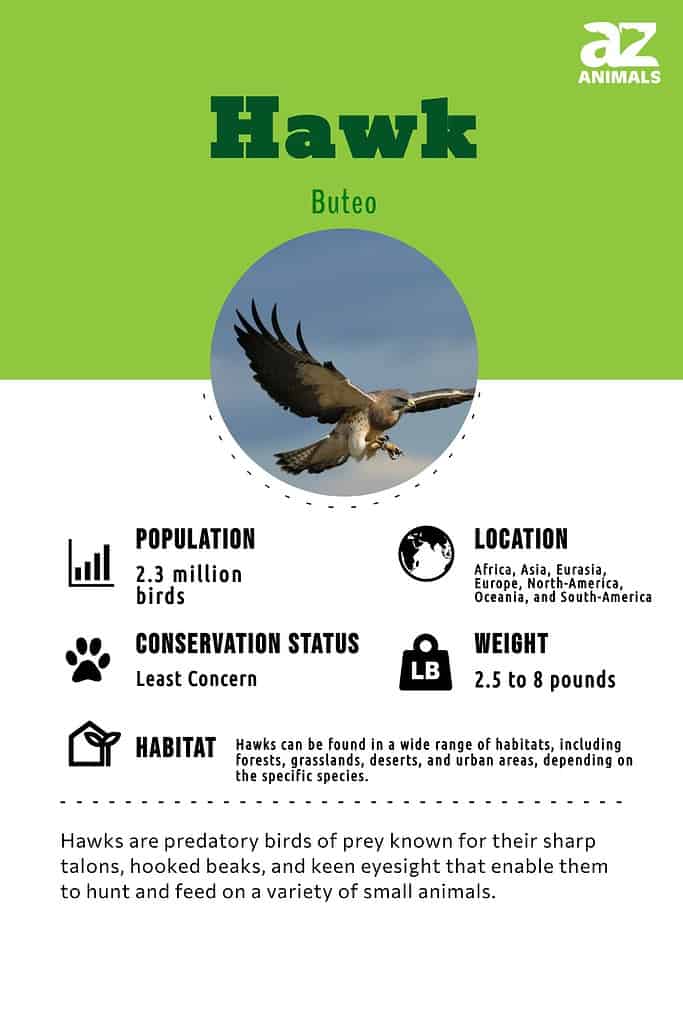
While the Ferruginous hawk is the largest species in the USA, Asia’s Upland buzzard is the biggest overall.
A hawk is not one specific bird of prey; it’s a general name used to describe 270 different types of diurnal carnivorous birds. These birds all fall under the order Falconiformes, which go by many names, like raptors, hawks, and buzzards.
While each species of a hawk has its own unique features, they all have many characteristics in common, like sharp eyesight, hooked beaks, and sharp talons. However, they vary significantly in size.
Hawks are deadly assassins that reign terror from the skies. They dive, lighting quick to snatch an unsuspecting animal from the ground before it realizes what is happening.
Eight Hawk Facts
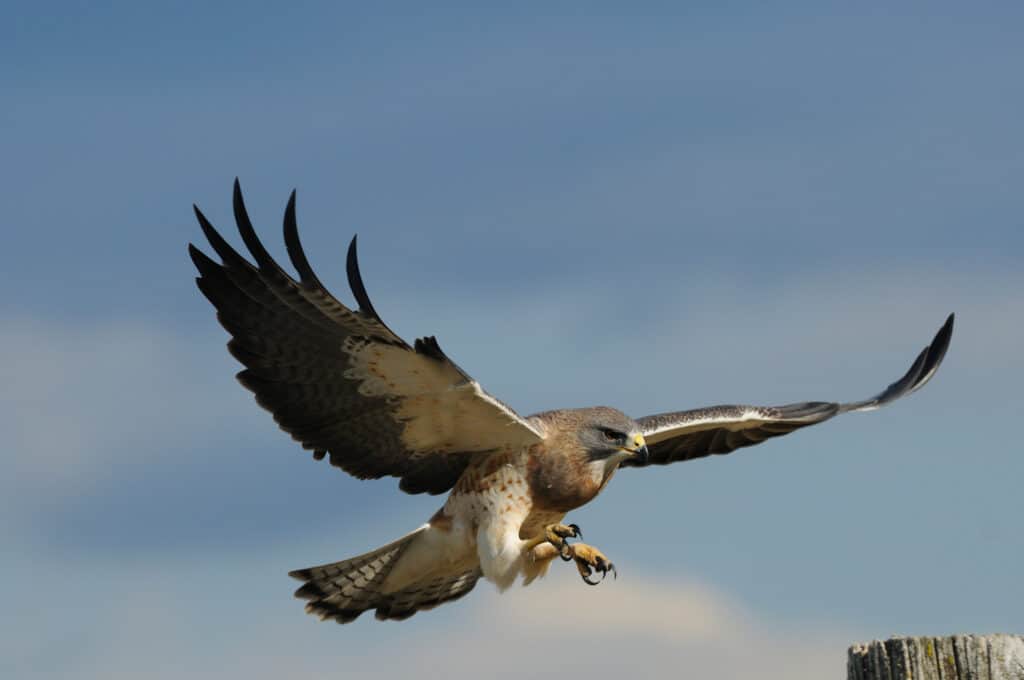
Swainson’s hawks are long-distance migrants, and almost the entire population moves from North America to South America during August and September.
©Rob McKay/Shutterstock.com
- There are 270 species of hawks, 25 of which are located in the USA
- The biggest hawk in North America is the ferruginous hawk
- The most populated hawk species in the USA is the red-tailed hawk
- Red-tailed hawks mate for life
- The only place in the world where hawks don’t exist in Antarctica
- Females are 25 to 30% bigger than the males
- A group of hawks is referred to as a Kettle
- Hawks can see 5 times better than people
Scientific Name
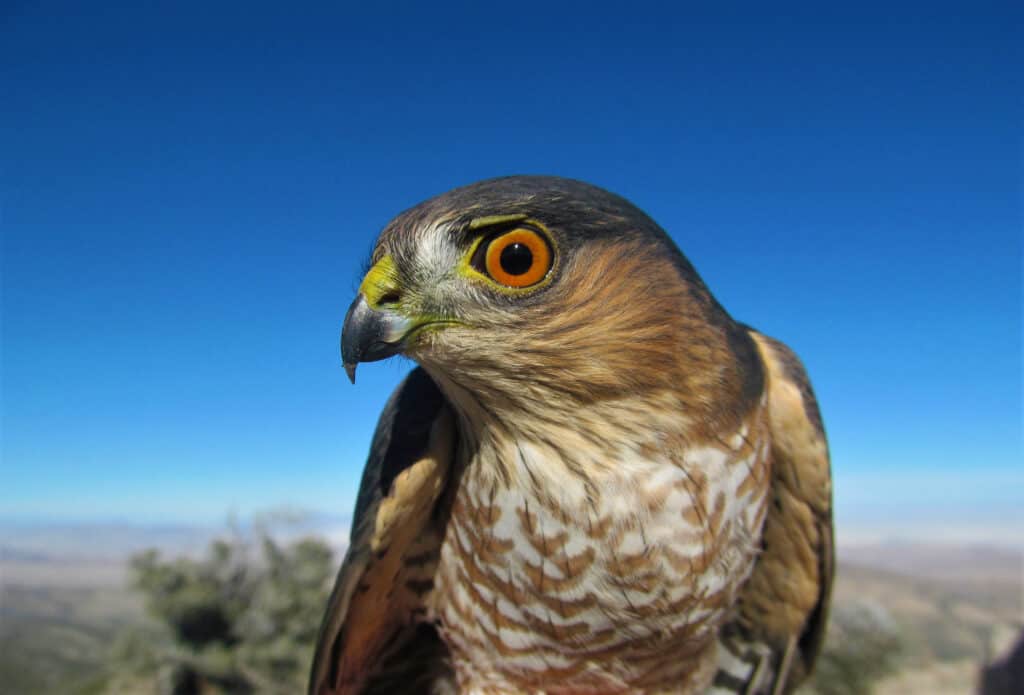
Sharp-shinned hawks have large eyes.
©RJ Ridley/Shutterstock.com
The scientific name for Hawks is Buteo, which describes medium-large, widely dispersed raptors with muscular bodies and wide wings.
They are often referred to as buzzards, which is the old terminology of the species; it changed to hawk in more recent times. In fact, the name Buteo is Latin for a buzzard.
Each species differs in features and size; here are a few species that fall under Buteo:
- Cape Verde buzzard
- Red-tailed hawk
- Socotra buzzard
- Rough-legged buzzard
- Madeira buzzard
- Long-legged buzzard
- Steppe Buzzard
- Ferruginous hawk
- Red-shouldered hawk
Common Types of Hawks
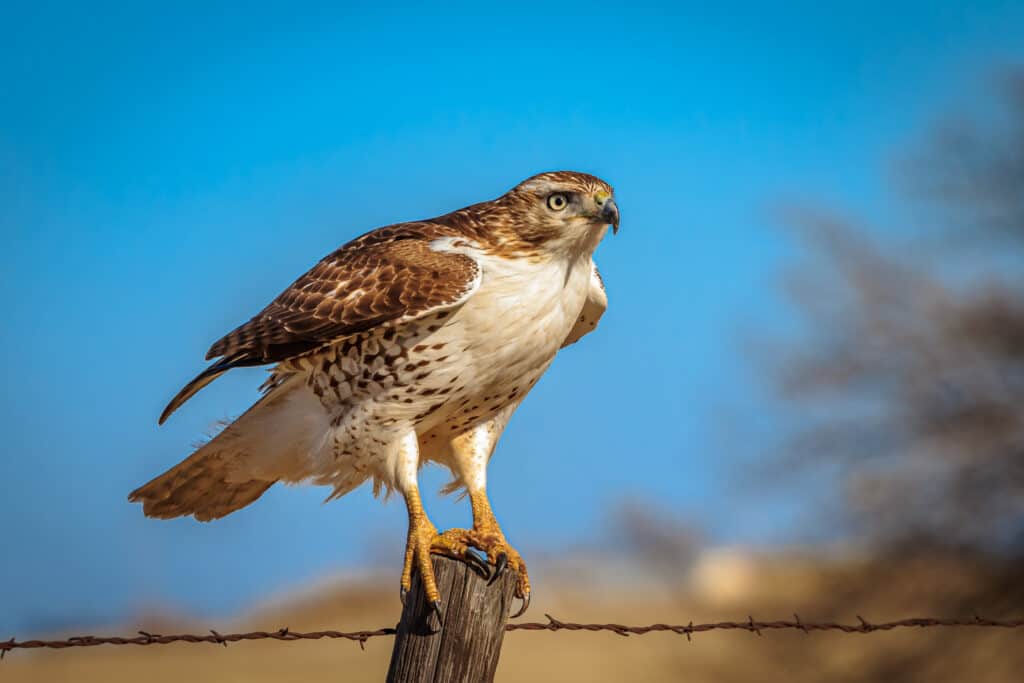
Buzzards and hawks mostly prey on live animals such as rodents and other small mammals.
©Richard G Smith/Shutterstock.com
There are 270 different species of hawk, so to make things easier, here is a list of the most common species:
- Cooper’s hawk
- Harris Hawk
- Red-tailed hawk
- Gray hawk
- Northern goshawk
- Great black hawk
- Northern harrier
- Sharp-shinned hawk
- Crane hawk
- Common buzzard
- Honey-buzzard
- Broad-winged hawk
- Roadside hawk
- Common black hawk
- Red-shouldered hawk
- Harris’s hawk
- Rough-legged hawk
- Zone-tailed hawk
- Swainson’s hawk
- Short-tailed hawk
- White-tailed hawk
- Ferruginous hawk
- Red-tailed hawk
- Eurasian sparrowhawk
- Sharp-shinned hawk
- Black kite
- Northern goshawk
- Cooper’s hawk
- Red-shouldered hawk
- Common buzzard
- Harris’s hawk
- Osprey
- Broad-winged hawk
- Roadside hawk
- Common kestrel
- Brown falcon
- White-tailed hawk
- American kestrel
- Ferruginous hawk
- Rough-legged buzzard
- Swainson’s hawk
- Northern harrier
- Crested honey buzzard
- Eastern buzzard
- Crested serpent eagle
- Great black hawk
- Shikra
- Red kite
- Common black hawk
- Japanese sparrowhawk
- Grey goshawk
- Savanna hawk
- Aplomado Falcon
- Grey-faced Buzzard
- Lanner falcon
- Crested goshawk
- Hen harrier
- Prairie falcon
- Black-winged kite
- Chinese sparrowhawk
- Black Falcon
- European honey buzzard
- Cinereous vulture
- Red-footed Falcon
- Ornate hawk-eagle
- Barbary Falcon
- Western marsh harrier
- Black-chested buzzard-eagle
- White-tailed kite
- Black-and-white hawk-eagle
- Brahminy kite
- Zone-tailed hawk
- Besra
Appearance
Hawks vary in size, with the lightest species being the roadside hawk, which weighs only 9.5 ounces. Their length can stretch 12 to 28 inches, while hawks’ wingspan ranges from 26 to 63 inches.
For example, the white-rumped and Ridgway hawk’s wingspan measures 30 inches, and their length averages 14 inches.
While the ferruginous hawk is the largest species in the USA, Asia’s Upland buzzard is the biggest overall. They are 26 inches long with a wingspan of 60 inches. However, the ferruginous hawk weighs the same and has bigger foot measurements and bill size. Males are smaller, only weighing 2.5 pounds, while females average 4.4 pounds when fully grown.

Depending on the species, a hawk’s wingspan can range from 26 to 63 inches. This is a white-tailed hawk.
©iStock.com/neil bowman
Evolution and Origins
Hawks developed in Africa and falcons in South America independently after the division of Gondwana into those three continents around 100 million years ago. It seems as though each location received a diurnal raptor that was necessary for that habitat.
Theropods were a class of meat-eating dinosaurs from which birds descended. Although birds originated from little theropods rather than gigantic ones like Tyrannosaurus rex, they nonetheless belong to the same group as the dinosaur. The earliest fossilized bird remains date back 150 million years.
Between 50 and 35 million years ago, during the Eocene Epoch, a generic raptor was known. The earliest known raptor dates from the late Paleocene Epoch (57.9 to 54.8 million years ago), and it may have been a New World vulture.
Habitat
Hawks dominate the world and thrive in all sorts of climates and environments. The only place on the planet they don’t inhabit is Antarctica. They can survive as long as there is prey to eat and a safe place to nest.
Most hawk species migrate, but a few don’t; generally, if the hawk in question does not flock, it means they do not migrate.
Diet
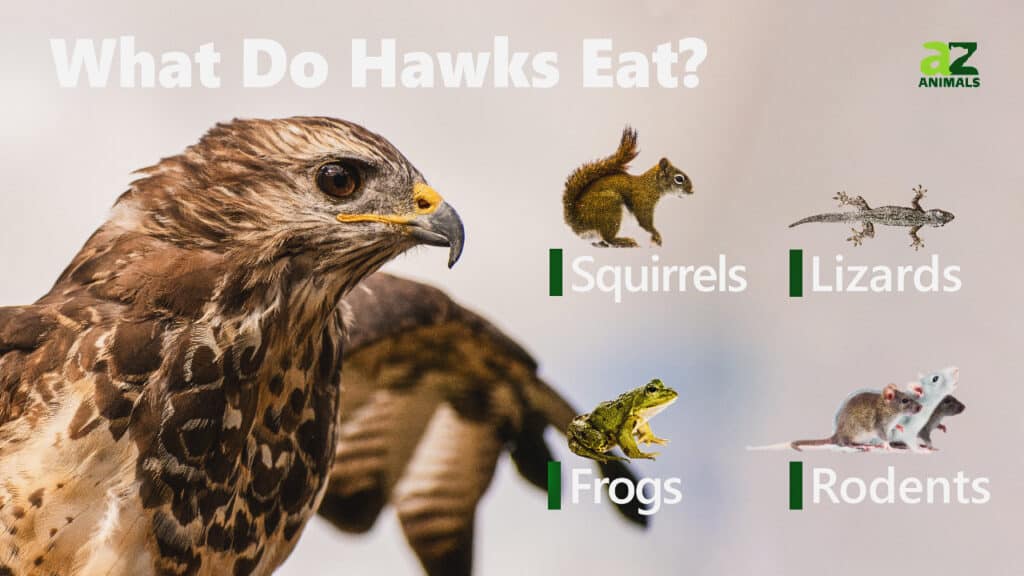
Most birds of prey are opportunistic hunters and are not picky. They will take a meal wherever they can find it, but typically, their food of choice is rodents. Unfortunately, for the hawks, most rodents are active at night, so most of their diet consists of diurnal gerbils, squirrels, voles, and chipmunks.
Other prey includes:
- Shrews
- Moles
- Pikas
- Weasels
- Rabbits
- Hares
- Marmots
- Small to medium-sized birds
- Snakes
- Lizards
- Frogs
- Salamanders
- Fish
- Various invertebrates
Predators and Threats
Fully-grown hawks generally have very few predators. Their razor-sharp beaks and talons are a great deterrent, and they can fly away from larger animals.
Hawks are considered apex predators, which means they are at the top of the food chain in their environment. However, nature is fickle, and anything is possible; sometimes, predators like coyotes and foxes will take an opportunity to kill and eat a hawk, but it rarely happens.
While coyotes and foxes are opportunistic hunters and will eat anything in their path, they do have preferences, and hawks are not one of them. Generally, they stick to smaller mammals like rabbits but can also eat grass, fruit, and carcasses.
Sadly, hawk eggs and chicks are often targets of owls, larger birds of prey, crows, raccoons, porcupines, ravens, and snakes. As a result, mothers must keep their eggs and babies hidden until they are old enough to protect themselves.
Reproduction, Babies, and Lifespan
Like most species of birds, hawks build nests usually constructed of sticks, leaves, and other materials. For hawks who nest in trees, selecting the perfect tree needs a lot of consideration. Hawks need to ensure their tree is large or hidden enough, making it inaccessible to predators who can climb.
Most species will mate for life or at least for several years; this includes migratory species where pairs separate for the winter.
Hawks can lay between 2 to 7 eggs at a time; most of the time, the female will incubate the eggs, and the male will go out and hunt.
When the eggs hatch, the chicks rely solely on their parents to provide safety and food. Their survival depends on the location of the nest, nearby predators, and whether there is human activity such as logging or hunting in the area.
The eggs do not all hatch at once; there are usually intervals of a day or two, which means the older, stronger chicks have a better chance of survival as they can fight for their food, and sometimes kill their smaller siblings by aggressively handling them.
The female spends most of the time with the chicks while the male is out hunting. However, males do brood with chicks from time to time.
When the chicks reach their fledgling stage, the mother takes over the majority of the hunting. After a couple of weeks, the fledglings realize their parents are indifferent to feeding them. Sometimes they are even hostile toward the chicks, and they know it’s time to leave the nest.
The fledglings initially stay close to their old nest, usually within several miles. Then, after one or two years of being on their own, they start to court mates and create their own families.
Hawks generally live up to 12 years; however, in captivity, they can grow much older. This is due to predators and environmental threats in the wild.
Population
Because “hawk” is a term used for 270 species, it’s hard to accurately determine their population size. Some hawks, like the red-tailed hawk, have huge numbers, while other species like the Ridgeway hawk are critically endangered.
For example, there are around 1,960,000 nesting red-tailed hawks in the world, and 90% of their population call North America home.
The Difference Between Eagles and Hawks
Eagles and hawks both belong to the Accipitridae family and have a lot of similar characteristics, which is why they are so hard to tell apart.
One significant difference is not in their appearance but in their numbers because there are only about 60 species of eagles, while there are 270 different species of hawks.
Both genuses are indigenous to:
- Grasslands
- Forests
- Alpine Meadows
- Deserts
- Coastal regions
- Suburban and urban areas
In addition, they are both diurnal, meaning they are primarily active during the day. Because they occur in various habitats, their diets, amongst other things, do differ.
Appearance
Typically eagles have a bigger build compared to hawks and weigh around 18 pounds, while even the largest species of hawk barely reaches 8 pounds.
However, there are exceptions; For example, the red-tailed hawk is bigger than the Australian little eagle, only weighing 1.8 pounds.
Eagles are typically stronger than hawks because they have more muscular bodies, powerful legs, hooked beaks, and curved talons. In fact, their hind talons are extremely strong, helping to facilitate gripping and carrying heavy prey.
Hawks also have hooked beaks and razor-sharp talons, but not to the extent of eagles. In addition, both species have feathers partially covering their legs.
Wingspan
There is a significant difference between an eagle’s and a hawk’s wingspan, with eagles generally reaching 8 feet and hawks less than 5 feet. But, surprisingly, hawks can soar for much longer periods than eagles.
Characteristics
Both genuses vary in color, but eagles are typically a mixture of gold, brown, and blackish-gray feathers with a yellow or lightly colored beak.
On the other hand, hawks are generally a mixture of reddish-brown and grey with white feathers on their belly and chest. In addition, they have a dark-colored beaks.
Hunting
While both genuses have fantastic eyesight, which helps significantly in detecting prey, their hunting techniques differ slightly. Eagles soar until they swoop in on their prey mid-air, using their talons to grab and carry off their prey to the nearest perch. Once stable, the eagle will start to tear their meal apart.
Hawks are a bit more strategic when hunting, often hiding in trees until the opportunity arises. Then, once their prey is in sight, they swoop down and snatch them up before they even realize what is happening.
Diet
There is a big difference in size when it comes to each genuses’ prey. Eagles typically hunt larger animals like medium-sized vertebrates, snakes, birds, large fish, and various mammals.
While hawks sometimes hunt larger animals, they tend to stick to animals like:
Sound
Hawks make a high-pitched screeching noise, while eagle calls are subtle screams.
Eggs
Hawks reproduce more than eagles when it comes to the number of eggs laid. They generally lay between 2 to 7 eggs at a time and will build their nests on hills, cliffs, in trees, and, depending on the species, on the ground.
Eagles typically lay 2 eggs at a time and build their nests in high trees or on cliffs. The chicks are highly competitive, and the older or bigger chick usually kills its sibling to obtain more food.
The Difference Between Hawks and Falcons
Many think the only way to differentiate between hawks and falcons is by size alone, but that is not true. Typically falcons are smaller than hawks; however, members of both genuses can vary in size.
So, size is not the only way to tell them apart. In addition, when birds are in flight, it’s hard to tell how big or small they are. Instead, there are other characters that set them apart.
Wing Shape
The shape of their wings is the clearest way to tell the two birds apart. Hawks wings are broader compared to their bodies and end with rounded tips, while falcons have long, thin wings that end in points.
In addition, larger hawks, like the ferruginous hawk, have well-defined, separated feathers on the tips of their wings that help them maneuver better. Whereas falcons have an impressive aerodynamic shape that is built more for speed than precision.
Flight Pattern
Observing flight patterns is another great way to differentiate the two birds of prey. Falcons have narrower wings, so they have to beat their wings more rapidly, with short periods of gliding in between.
Because hawks have broader wings and a tremendous proportional surface area, they don’t have to flap their wings as often and tend to glide more.
The Head
If these birds aren’t flying, you can tell them apart by their heads. Hawks have pointed, sleek heads, while falcons’ heads are generally rounded and short.
People with attention to detail can differentiate between these two species by the hawks’ long tails and the falcon’s prominent facial markings; however, these identifiers are less reliable. Furthermore, these distinguishing features can be misleading, so they should always be identified with other information and observations.
Zoos
The majority of zoos house some type of hawk. The most popular species in the USA is the red-tailed hawk, which you can find in the following zoos:
View all 104 animals that start with HHawk FAQs (Frequently Asked Questions)
Is hawk a bird of prey?
Yes, a hawk is not one specific bird of prey; it’s a general name used to describe 270 different types of diurnal carnivorous birds. These birds all fall under the order Falconiformes, which go by many names, like raptors, hawks, and buzzards.
What are the 4 birds of prey?
Each species differs in features and size; here are a few species that fall under birds of prey: cape verde buzzard, red-tailed hawk, Socotra buzzard, and rough-legged buzzard.
Does the USA have hawks?
There are 270 species of hawks, 25 of which are located in the USA.
What does seeing a hawk mean?
A hawk is aways a welcome symbole for freedom and hope. Seeing a hawk symbolizes being creative, and that you should express yourself through art.
Thank you for reading! Have some feedback for us? Contact the AZ Animals editorial team.
Sources
- The Raptor Trust, Available here: https://theraptortrust.org/bird-resources/bird-facts/hawk-facts/#:~:text=Hawks%20are%20strong%2C%20powerful%20birds,over%20150%20mph%20when%20diving.
- Britannica, Available here: https://www.britannica.com/animal/hawk-bird
- Beauty of Birds, Available here: https://www.beautyofbirds.com/hawks.htm
- WIKIPEDIA, Available here: https://en.wikipedia.org/wiki/Accipitridae
- Birds and Blooms, Available here: https://www.birdsandblooms.com/birding/hawk-id-tips/

















